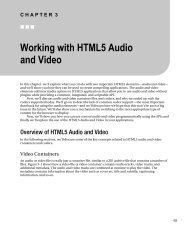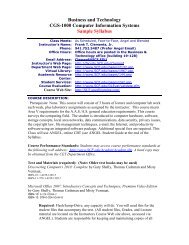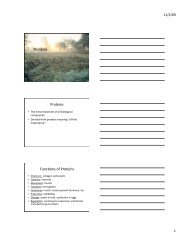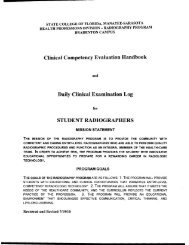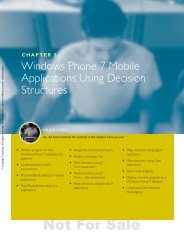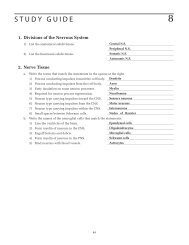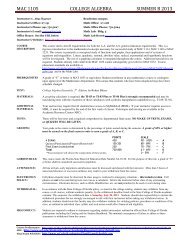EC-Council Certified Ethical Hacker v6.1
EC-Council Certified Ethical Hacker v6.1
EC-Council Certified Ethical Hacker v6.1
You also want an ePaper? Increase the reach of your titles
YUMPU automatically turns print PDFs into web optimized ePapers that Google loves.
<strong>EC</strong>-<strong>Council</strong> <strong>Certified</strong> <strong>Ethical</strong> <strong>Hacker</strong> <strong>v6.1</strong><br />
Cheat Sheet Exercises
How to Use the Cheat Sheets<br />
Students often report that the most difficult thing about the CEH exam is the terms, tools, numbers, log files,<br />
packet dumps and example scripts. None of these items can be understood without the concepts that give them<br />
meaning, but once the concepts are clear, it is still necessary to be exposed to the raw data until they are second<br />
nature.<br />
Cheatsheets are exercises that can be used to assist with memorization and refresh before the time of the exam.<br />
They are not comrehensive reference guides. They are designed to provide only enough data to trigger the<br />
memory or assess what needs to be better understood.<br />
Having a list of everything at your fingertips is helpful on the job but is almost useless as a study tool.<br />
You must interract with the data in order to convert it to information and own it.<br />
Since the exam is not open book, the goal is in fact to get to a point where you no longer need the cheat sheets at<br />
all.<br />
Each cheat sheet is a concept object. These are examples to get you started and provide enough information to<br />
establish a grasp of the object at hand. Print them out, and hand copy each one in your own writting to another<br />
sheet of paper. Arrange the material in your own way, and add notes to them as you study.<br />
Practice this at least three times. On the third try you may find you can copy the entire thing without looking at the<br />
original. Then you have mastered it, and will have problems recalling important data druing the real exam.<br />
In summary, to get the most out of these study aids, follow these simple tips:<br />
1. Check back often for new versions<br />
2. Print them out and copy them by hand to a blank piece of paper; three times.<br />
3. Take additional notes, fill in any information that seems to be missing
Chapter Map for the Cheat Sheets<br />
01 <strong>Ethical</strong> Hacking CEH Prerequisites<br />
Terms and Definitions<br />
Methodologies<br />
02 Hacking Laws Legal Issues<br />
03 Footprinting Domain Name Service<br />
04 Google Hacking Google Hacking<br />
05 Scanning NMap Scan Types<br />
TCP Handshake<br />
Ports and Protocols<br />
06 Enumeration Enumeration<br />
07 System Hacking Password Cracking<br />
08 Trojans and Backdoors Trojans and Malware<br />
09 Virus and Worms Virus Trivia<br />
10 Sniffing, Spoofing, Hijacking Sniffing<br />
MAC Addresses<br />
Internet Protocol<br />
Internet Control Message Protocol<br />
User Datagram Protocol<br />
Transmission Control Protocol<br />
11 Social Engineering Social Engineering<br />
12 Denial of Service DoS and DDoS Tools<br />
13 Buffer Overflows Buffer Overflows<br />
14 Web Servers and Applications HTTP and URLs<br />
15 Wireless Networks Wireless Technology<br />
Wardriving<br />
16 Cryptography Cryptography<br />
17 Hacking Linux Linux Operatinig System<br />
Linux Commands<br />
18 IDS, Firewalls, Honeypots Firewalls and IPTables<br />
IDS and Snort<br />
** Misc Cheat Sheets Command Line Tools<br />
Syntax Recognition<br />
Random Recall Exercise
CEH Prerequisites<br />
There are entry level security classes, but security is not an entry level subject. In order to be comfortable with<br />
the CEH training, pre-requisites are assumed and test items will involve topics that time might not permit covering<br />
during the live trainging. Prior to training, try to refresh your skill sin the following areas. The more time spent on<br />
this step the more comfortable the training experience will be.<br />
Know the basics of Information security<br />
Concepts such as "CIA (Confidentiality, Integrity, Availability)<br />
Coverage would have come during CompTIA or CISSP training<br />
Know the basics of networking<br />
Physical layer, cabling, hardware devices<br />
The function of switches, routers, firewalls<br />
IP Addressing, Subnetting and CIDR notation<br />
Know how to convert numbers<br />
Decimal, Octal, Binary; in all directions and combinations<br />
Know the basics of Cryptography<br />
There is a module in the class on Crypto, but there may not be time to cover it in class.<br />
Sufficient coverage would have come during CompTIA Security+ or CISSP<br />
Know the OSI model<br />
Application 7 Service protocols<br />
Presentation 6 Data formats<br />
Session 5 Authentication, Cryptographic agreements<br />
Transport 4 Ports, logical service to service connections<br />
Network 3 Network to network delivery<br />
Data Link 2 Host to host links, contention<br />
Physical 1 Media<br />
Know how to use a Windows PC<br />
Be familiar with the Windows Graphical User Interface<br />
Find toolbar icons, manage folders and files, use network shares<br />
The labs in this class are difficult and must move rapidly,<br />
slowdowns for poor PC skills may result in just watching the demonstration at times, please be understanding of<br />
this and courteous to the other students.
Terms and Definitions<br />
Read the following terms and makwe sure you know their meaning. Look up any that you are not comfortable<br />
with. On your own cheat sheet, jot down any additional terms you run across that struck you as new or odd.<br />
Term Definition<br />
Hax0r <strong>Hacker</strong><br />
Uberhacker Good hacker<br />
L33t Sp33k Replacing characters to avoid filters<br />
Full disclosure Revealing vulnerabilities<br />
Hacktivism Hacking for a cause<br />
Suicide <strong>Hacker</strong> Hopes to be caught<br />
<strong>Ethical</strong> <strong>Hacker</strong> Hacks for defensive purposes<br />
Penetration Test Determine true security risks<br />
Vulnerability Assessment Basic idea of security levels<br />
Vulnerabilty Researcher Tracks down vulnerabilities<br />
White hat Hacks with permission<br />
Grey hat Believes in full disclosure<br />
Black hat Hacks without permission<br />
White Box A test everyone knows about<br />
Grey Box A test with a very specific goal but unspecific means<br />
Black Box A test no one knows is happening<br />
Threat Potential event<br />
Vulnerability Weakness<br />
Exposure Accessibility<br />
Exploit Act of attacking<br />
TOE Target of Evaluation<br />
Rootkit Hides processes that create backdoors<br />
Botnet Robot network that can be commanded remotely<br />
Buffer Overflow Hijack the execution steps of a program<br />
Shrinkwrap Code Reused code with vulnerabilities
Methodologies<br />
This class tells a story, and understanding that story is far more important than memoriing these lists. Think<br />
about what actions are taken during each phase, and notice how they logically progress.<br />
The phases of an attack<br />
1. Reconnaissance Information gathering, physical and social engineering, locate network range<br />
2. Scanning - Enumerating Live hosts, access points, accounts and policies, vulnerability assessment<br />
3. Gaining Access Breech systems, plant malicious code, backdoors<br />
4. Maintaining Access Rootkits, unpatched systems<br />
5. Clearing Tracks IDS evasion, log manipulation, decoy traffic<br />
Information Gathering<br />
1. Unearth initial information What/ Who is the target?<br />
2. Locate the network range What is the attack surface?<br />
3. Ascertain active machines What hosts are alive?<br />
4. Open ports / access points How can they be accessed?<br />
5. Detect operating systems What platform are they?<br />
6. Uncover services on ports What software can be attacked?<br />
7. Map the network Tie it all together, document, and form a strategy.
Legal Issues<br />
Be able to describe the importance of each of these items. The exam will not go into depth on this, just be<br />
prepared to identify the issues.<br />
United States<br />
Computer fraud and abuse act Addresses hacking activities<br />
18 U.S.C. 1029 Possession of Access Devices<br />
18 U.S.C. 1030 Fraud and Related Activity in Conncetion with Computers<br />
CAN-SPAM Defines legal eMail marketing<br />
SPY-Act Protects vendors monitoring for licence enforcement<br />
DMCA - Digital Milenium Copyright Act Protects intellectual property<br />
SOX - Sarbanes Oxley Controls for corporate financial processes<br />
GLBA - Gramm-Leech Bliley Act Controls use of personal financial data<br />
HIPPA - Health Imformation Portability and Protection Act Privacy for medical records<br />
FERPA - Family Educational Rights and Privacy Act Protection for education records<br />
FISMA - Federal Information Security Management Act Government networks must have security standards<br />
Europe<br />
Computer misuse act of 1990 Addresses hacking activities<br />
Human Rights Act of 1990 Ensures privacy rights
Domain Name Service<br />
DNS is critical in the footprinting of a target network. It can sometimes save the attacker a lot of time, or at least<br />
corroborate other information that has been gathered. DNS is also a target for several types of attack.<br />
Fields in the SOA record: (Time in seconds)<br />
1882919 7200 3600 14400 2400<br />
Serial Refresh Retry Expiry TTL<br />
Requesting a zone transfer<br />
nslookup; ls -d example.dom<br />
dig @ns1.example.dom AXFR<br />
host -t AXFR example.dom ns1.example.dom<br />
Using Whois<br />
whois example.dom<br />
Regional Internet Registrars<br />
ARIN (North America)<br />
APNIC (Asia Pacific Region)<br />
LACNIC (Southern and Central America and Caribbean)<br />
RIPE NCC (Europe, the Middle East and Central Asia)<br />
AfriNIC (Africa)<br />
Attacks against DNS servers<br />
Zone transfers Information gathering shortcut<br />
Zone poisoning Breach the primary server and alter the zone file to corrupt the domain<br />
Cache poisoning Send false answers to cache servers until they store them<br />
Reflection DoS Send bogus requests into a chain of servers that do recursive queries
Google Hacking<br />
An attacker will use Google to enumerate a target without ever touching it. The advanced search syntax is easy<br />
to use but can be quirky at times. It takes practice and experimentation.<br />
Using Advanced Search<br />
operator:keyword additional search terms<br />
Advanced Operators<br />
site Confines keywords to search only within a domain<br />
ext File extension<br />
loc Maps location<br />
intitle Keywords in the title tag of the page<br />
allintitle Any of the keywords can be in the title<br />
inurl Keywords anywhere in the URL<br />
allinurl Any of the keywords can be in the URL<br />
incache Search Google cache only<br />
Keyword combinations<br />
passsword | passlist | username | user<br />
login | logon<br />
Administrator | Admin | Root<br />
Prototype | Proto | Test | Example<br />
Examples<br />
site:intenseschool.com (ceh ecsa lpt)<br />
intitle:index.of<br />
allinurl:login logon<br />
-ext:html -ext:htm -ext:asp -ext:aspx -ext:php
Nmap Scan Types<br />
Nmap is the de-facto tool for footprinting networks. It is capable of finding live hosts, access points, fingerprinting<br />
operating systems, and verifying services. It also has important IDS evasion capabilities.<br />
Discovery Scans<br />
Option Description<br />
-sP Ping<br />
-sL List Scan<br />
-sO Protocol<br />
-sV Verify<br />
-sL List scan<br />
Normal Scans<br />
Windows Linux<br />
Option Desc Flags Open Closed Open Closed<br />
-sT Connect S SA RA SA RA<br />
-sS Stealth S SA RA SA RA<br />
Inverse Scans<br />
Windows Linux<br />
Option Desc Flags Open Closed Open Closed<br />
-sN Null - RA RA - RA<br />
-sX Xmas UPF RA RA - RA<br />
-sF Fin F RA RA - RA<br />
-sA Ack A R R R R<br />
-sW Window A R R R R<br />
Other Important Nmap Options<br />
Option Description<br />
-A Enable OS detection, Version detection, Script scanning and Traceroute<br />
-n Do not lookup DNS<br />
-v Verbose output<br />
-T [0-5] Timing - 5 is faster<br />
-P0 Do not ping first
TCP Flags<br />
This test will have scenarios that require you demonstrate an understanding of TCP behavior including Nmap<br />
scan types. Be sure to know each of these combinations well.<br />
TCP Flags<br />
0 0 URG ACK PSH RST SYN FIN<br />
TCP Handshake (Open Port)<br />
Direction Binary Hex Flags<br />
A -> B 00000010 0x02 S Seq = 1 Ack = 0<br />
B -> A 00010010 0x12 A S Ack = 2 Seq = 10<br />
A -> B 00010000 0x10 A Seq = 2 Ack = 11<br />
TCP Handshake (Closed Port)<br />
A -> B 00000010 0x02 S Seq = 1 Ack = 0<br />
B -> A 00010100 0x14 A R Ack = 2 Seq = 0<br />
NMap Stealth Scan (Open Port)<br />
Direction Binary Hex Flags<br />
A -> B 00000010 0x02 S<br />
B -> A 00010010 0x12 A S<br />
A -> B 00000100 0x04 R<br />
NMap Xmas Scan (Open Port)<br />
Direction Binary Hex Flags<br />
A -> B 00101001 0x29 U P F<br />
No response from Linux hosts, R A from Windows<br />
NMap ACK Scan<br />
Direction Binary Hex Flags<br />
A -> B 00010000 0x10 A<br />
A -> B 00000100 0x04 R<br />
Solaris will not respond on open ports
Ports and Protocols<br />
These must be memorized! Also be prepared to convert them to hexadecimal representation in case they must<br />
be identified in a packet dump, log file, IDS rule, or a sniffer capture/display filter.<br />
Protocols<br />
1 ICMP<br />
6 TCP<br />
17 UDP<br />
47 GRE<br />
50 AH<br />
51 ESP<br />
Ports<br />
20 - 21 FTP<br />
22 SSH<br />
23 Telnet<br />
25 SMTP<br />
42 WINS<br />
53 DNS<br />
80 - 81 -8080 HTTP<br />
88 Kerberos<br />
110 POP3<br />
111 Portmapper (Linux)<br />
119 NNTP<br />
135 RPC-DCOM<br />
137 - 138 - 139 SMB<br />
143 IMAP<br />
161 - 162 SNMP<br />
389 LDAP<br />
445 CIFS<br />
1080 SOCKS5<br />
3389 RDP<br />
6667 IRC<br />
14237 Palm Pilot Remote Sync<br />
Trojan Horses<br />
7777 Tini<br />
12345 NetBus<br />
27374 Back Orifice<br />
31337 Sub7
Enumeration<br />
Enumeration is the act of making a list of policies, user accounts, shares and other resources. This step happens<br />
just before vulnerability assessment and helps the attack put together the best strategy for gaining access.<br />
Establishing a Null Session<br />
net use \\[target ip]\IPC$ "" /user:""<br />
Protecting Information Disclosure<br />
HKEY_LOCAL_MACHINE\SYSTEM\CurrentControlSet\Control\LSA\RestrictAnonymous<br />
“0” is the default for Windows 2000 and gives up everything<br />
“1” is the default for Windows 2003 and gives up less<br />
“2” is the most secure setting but makes a machine not very cooperative with others<br />
Microsoft SIDs<br />
S-1-5-21--500 Built-in Local administrator<br />
S-1-5-21--501 Built-in Local guest<br />
S-1-5-21--512 Built-in Domain administrator<br />
S-1-5-21--1000 Anything above 1000 are users that have been created<br />
Ports involved with enumerations attacks<br />
111 Linux Portmapper Service<br />
42 WINS<br />
88 Kerberos<br />
135 Windows RPC-DCOM<br />
137 NetBIOS Name Service<br />
138 NetBIOS Datagram Service<br />
139 NetBIOS Sessions<br />
161 SNMP Agent<br />
162 SNMP Traps<br />
389 LDAP<br />
445 CIFS (Common Internet File System)<br />
Misc.<br />
"public" and "private" default community SNMP strings<br />
1.1.1.2.1.0.0.1.3.4.1.4 is an SNMP OID<br />
ou=sales,cn=example... is an LDAP (LDIF) name string<br />
fingerd the finger daemon was used in older UNIX systems
Password Cracking<br />
This test will have scenarios that require you demonstrate an understanding of TCP behavior. Be sure to know<br />
each of these combinations well.<br />
Types of password cracking techniques<br />
Guessing Is the most efficient, assuming information gathering before hand<br />
Dictionary Based on a predetermined list of words<br />
Brute Force Trying every possible combination of characters<br />
Hybrid A combination of all other attacks<br />
LM Hashes<br />
Every password is ultimately 14 characters long, split into two 7 character halved<br />
Passwords that are less than 7 character are easily identified in the SAM file (hash ends in 404EE)<br />
Rainbow Tables<br />
"Time / Memory Trade off"" Less memory than a lookup, less computing than a brute force.<br />
Salting the hash is a way to combat rainbow tables.<br />
Cracking Effort<br />
Weak passwords can be cracked in seconds<br />
Strong passwords might take the lifetime of several universes to crack<br />
Rainbow Tables Solve the "Time / Memory Trade Off"<br />
DNA Distributed Network Architecture<br />
Popular Cracking Tools<br />
John the Ripper Command line tool that runs under both Windows and Linux<br />
L0phtcrack Commercial tool<br />
0phtcrack Open source tool that supports rainbow tables<br />
Cain and Abel Powerful multipurpose tool that than sniff and crack passwords af many types
Trojans and Malware<br />
The official definition is: A legitimate application that has been modified with malicious code. A Trojan horse is a<br />
social engineering technique. It masquerades as a legitimate download and injects the victim's host with an<br />
access point, or a client that can connect outbound to a server waiting remotely. They don't necessarily exploit a<br />
vulnerability unless privilege escalation is necessary. They provide a command environment for whoever<br />
connects to them that includes: File browsers, keyloggers, web cam viewer, and many additional tools.<br />
Terms<br />
Wrapper or Binder Application used to combine a malicious binary and a legitimate program<br />
Rootkit Can be installed via Trojan, used to hide processes that create backdoor access<br />
HTTP Trojan Reverses a connection outbound through an HTTP or SHTTP tunnel<br />
Netcat Not really a Trojan, but often used in Trojan code to setup the listening socket<br />
Hoax Many legit tools are rumored to be Trojans but might not be<br />
Keylogger Records the keystrokes on the install host and saves them in a log<br />
Famous Trojans<br />
Tini Small 3Kb file, uses port 7777<br />
Loki Used ICMP as a tunneling protocol<br />
Netbus One of the first RATs (Remote Authentication Trojan)<br />
Sub 7 Written in Delphi, expanded on what Netbus had demonstrated<br />
Back Orifice First modular malware, had the capabilities to be expanded on by outside authors<br />
Beast All in one Client / Server binary<br />
MoSucker Client could select the infection method for each binary<br />
Nuclear RAT Reverse connecting Trojan<br />
Monkey Shell Provides a powerful shell environment that can reverse connections and encrypt<br />
commands.<br />
Detecting Trojans<br />
netstat / fport Command line tools for viewing open ports and connections<br />
tcpview GUI tool for viewing open ports and connections<br />
Process Viewer GUI tool for showing open processes including child processes<br />
Autoruns Lists all programs that will run on start up and where they are called from<br />
Hijack This Displays a list of unusual registry entries and files on the drive<br />
Spybot S&D Originally volunteer supported scanning and detection tool
Virus Trivia<br />
No one is expecting you the student to stay on top of the 40k or so known malware variants that have been<br />
discovered. But there are a few that are significant for demonstrating the capabilities of this method of attack.<br />
Think of the malware mentions in the course as examples of what thousands of others have copied or improved<br />
upon.<br />
Phases of an outbreak<br />
Infection -> Spreading -> Attack<br />
Virus Lifecycle<br />
Design - > Replication -> Launch -> Detection -> Incorporation -> Elimination<br />
Types of Viruses<br />
Boot Virus Infects the boot sector of floppies or hard disks<br />
Macro Virus Written in Microsoft Office Macro language<br />
Network Virus Spreads via network shares<br />
Stealth Virus Hides in a file, copies itself out to deliver payload<br />
Polymorphic Virus Encrypts itself<br />
Cavity Virus Hides in the empty areas of executables<br />
Tunneling Virus Trace interceptor programs that monitor OS Kernel requests<br />
Camouflage Virus Disguise themselves as legit files<br />
Multipartite Virus Infects via multiple vectors<br />
Metamorphic Virus Rewrites itself<br />
Famous Viruses<br />
Elk Cloner 1st virus<br />
Morris 1st worm<br />
I Love You VBScript worm, sent via email<br />
Melissa Macro virus<br />
Klez Mass mailer with its own SMTP engine<br />
Slammer Targets SQL server, total size of 376 bytes<br />
MyDoom Mass mailer, uses port 3127, attacks the hosts file<br />
MonteCarlo Memory resident, copies to the end on exe files
Sniffing<br />
Social Engineering is the most powerful attack tool. It requires no equipment or technology, and often minimal<br />
expense. Only proper user education and awareness can prevent it and even then, errors in judgment can still be<br />
exploited.<br />
Methods for defeating a switch<br />
Admin the switch If the password for the switch can be guessed, a port can be placed into monitor mode<br />
MAC Spoofing Set the MAC address of a NIC to the same value as another<br />
MAC Flooding Overwhelm the CAM table of the switch so it coverts to hub mode<br />
ARP Poisoning Inject incorrect information into the ARP caches of two or more endpoints.<br />
Wireshark command line tools<br />
tshark Command line version of Wireshark<br />
dumpcap Captures traffic<br />
capinfos Reads a saved capture file and returns statistics about it<br />
editcap Edit and/or translate the format of capture files<br />
mergecap Merges multiple capture files into one<br />
text2pcap Generates a capture file from an ASCII hexdump of packets<br />
tcpflow Extracts data streams from dump files<br />
tcptrace Analyzes TCP conversations<br />
tcpreplay Can resend capture packets<br />
TCPDump capture filters<br />
Capture filters will be kept simple on the test. They look basically like English phrases. Analyze the examples<br />
below to get an idea.<br />
host www.example.com and not (port 80 or port 25)<br />
port not 53 and not arp<br />
ip proto 1<br />
(tcp[2:2] > 1500 and tcp[2:2] < 1550<br />
Wireshark display filters<br />
Display filters work basically like: proto.field operator value<br />
Analyse the following examples:<br />
tcp.flags == 0x29<br />
ip.addr != 192.168.1.1<br />
tcp.port eq 25 or icmp<br />
ip.src==192.168.0.0/16 and ip.dst==192.168.0.0/16<br />
http.request.uri matches "login.html"
MAC Addresses<br />
Sniffing and defeating Ethernet switches requires an understanding of hardware addresses. Due to the risks<br />
involved with these local attacks, Intrusion Detection Systems are looking for too much ARP traffic or strange<br />
MAC addresses.<br />
The MAC 48 Format<br />
A Media Access Control address is 48 bits<br />
The first 3 bytes of the MAC is a vendor code<br />
The other three bytes are arbitrarily assigned<br />
A broadcast MAC address is<br />
FF:FF:FF:FF:FF:FF<br />
Addresses can be assigned in two ways<br />
BIA - Burned in Address<br />
OUI - Organizationally Unique Identifier<br />
The two least significant bits of the first byte in the OUI address<br />
nnnnnn0n = Universally administered address<br />
nnnnnn1n = Administratively assigned<br />
nnnnnnn0 = Unicast traffic<br />
nnnnnnn1 = Multicast traffic
Internet Protocol<br />
Internet protocol is responsible for packaging datagrams for delivery between networks. It is a "best effort"<br />
protocol with no error control or correction. For more information read RFC 791<br />
Internet Protocol Header<br />
Checklist of items to concentrate on:<br />
How IPIDs work<br />
How the fragmentation works<br />
How the TTL works<br />
Protocol IDs<br />
Basic IP addressing principles<br />
DoS attacks relating to IP
Internet Control Message Protocol<br />
ICMP is a transport protocol that creates message datagrams that can be exchanged by network hosts for<br />
troubleshooting, error reporting, and information. For more information read RFC 792<br />
For a complete list of type and codes visit http://www.spirit.com/Resources/icmp.html<br />
ICMP Header Example:<br />
Type Code Description<br />
0 0 Echo Reply<br />
3 Destination Unreachable<br />
3 13 Administratively Prohibited<br />
8 0 Echo Request<br />
5 0 Redirect<br />
11 0 Time Exceeded<br />
13 - Timestamp Request<br />
Don't forget!!<br />
Type 3 Code 13 means administratively prohibited
User Datagram Protocol<br />
User Datagram Protocol is a simple fast transport protocol that is used for its low overhead in situations where<br />
error correction and flow control is not needed, such as short bursts of messages. UDP is difficult to firewall off<br />
effectively because it is stateless. For more information read RFC 768<br />
User Datagram Protocol<br />
Checklist of items to concentrate on:<br />
Port addresses and ranges<br />
How ICMP and UDP assist each other<br />
UDP based Denial of Service Attacks
Transmission Control Protocol<br />
TCP provides guaranteed transport and flow control of layer 5-7 messages. Along with IP, ICMP, and UDP, a<br />
good solid understanding of this protocol is critical for understanding: Scanning, Firewalls, Intrusion Detection,<br />
and various types of DoS attacks. For more information read RFC 793<br />
Transmission Control Protocol<br />
Checklist of items to concentrate on:<br />
Port addresses and ranges<br />
Order of the six flags<br />
How the handshake works<br />
How the sequence numbers work<br />
How session hijacking works<br />
Denial of service attacks related to TCP
Social Engineering<br />
Social Engineering is the most powerful attack tool. It requires no equipment or technology, and often minimal<br />
expense. Only proper user education and awareness can prevent it and even then, errors in judgment can still be<br />
exploited.<br />
The principles of Social Engineering<br />
Authority An intimidating presence<br />
Scarcity Create the perception of loss or lack of access to a resource<br />
Liking Charm and charisma<br />
Reciprocation The victim believes they owe the attacker a favor<br />
Consistency Appealing the a victims true feelings and opinions<br />
Social Validation Compliments and praise<br />
Types of Social Engineers<br />
Insider Associates Have limited authorized access, and escalate privileges from there.<br />
Insider Affiliates Are insiders by virtue of an affiliation, they spoof the identity of the insider.<br />
Outsider Affiliates Are non‐trusted outsiders that use an access point that was left open.
DoS and DDoS<br />
Denial of Services and Distributed Denial of Service attacks are embarrassing and inconvenient. They are<br />
extremely difficult to prevent from being attempted. The best defense is a well designed network that is hard to<br />
overwhelm.<br />
DoS Methods<br />
Buffer Overflows Crashes applications or services<br />
Smurf Spoofed traffic sent to the broadcast address of a network<br />
Fraggle UDP version of the Smurf, usually bouncing Chargen traffic off Echo ports<br />
Ping of Death Packet larger than the 64k limit<br />
Teardrop Offset values modified to cause fragments to overlap during reassembly, results in<br />
short packet<br />
Unnamed Offset values modified to cause gaps between fragments, results in long packets<br />
Syn Flood SYN flags sent to open ports, no completion of the hansdshake<br />
Land Traffic sent to a victim spoofing itselft as the source, results in ACK storms<br />
Winnuke Sends TCP traffic with the URG flag set, causes CPU utilization to peak<br />
Dos Tools<br />
Jolt2 Floods with invalid traffic results in 100% CPU utilization<br />
Land and La Tierra Executes teardrop and land attacks<br />
Targa Provides a menu of several DoS attacks<br />
Blast20 Also considered to be a web server load tester<br />
Crazy Pinger ICMP flooder<br />
UDP Flood UDP flooder written by Foundstone<br />
DDos Attacks<br />
Botnets - Command and Control Center communicates with "Handlers" which in term communicate with Zombies.<br />
The handlers and zombies are machines infected with malware. The C&CC is either a chatroom on IRC, or can<br />
even be a distributed system of infected machines.<br />
DDoS Tools<br />
Trinoo One of the first to demonstrate "Master/slave" DDoS attacks<br />
Tribal Flood Network Could launch several DoS attacks from distributed positions at the same time<br />
TFN2K Bug fixes and updates to the original TFN<br />
Stacheldraht Means "Barbed Wire" in German<br />
Agobot A modular IRC bot, many derivatives have been created from this code<br />
Nuclear Bot Developed by "Nuclear Winter Crew" and written in Delphi, many features
Buffer Overflows<br />
It isn't necessary to become a "C" programmer to pass the test, but several basic concepts and terms are critical<br />
in the understanding of BO scripts and the detection of BO attacks.<br />
Terminology<br />
Stack Memory place for short term processing<br />
Heap Memory space for long term program execution<br />
Push "Push" new instructions onto the stack<br />
Pop "Pop" instructions off the stack when processed<br />
EIP Execute Instruction Pointer, memory address of next instruction to be executed<br />
NOOP A "do nothing" instruction that wastes a clock cycle<br />
NOOP Sled Placed in a buffer overflow exploit to aid in running the payload<br />
Dangerous Functions<br />
The following functions are dangerous because they do not check the size of the destination buffers:<br />
gets()<br />
strcpy()<br />
strcat()<br />
printf()<br />
The >> operator is also dangerous for the same reason<br />
Canary bytes<br />
String terminating characters:<br />
LF Line Feed<br />
CR Carriage Return<br />
NULL Null<br />
EOF End of File<br />
A randomly chosen value can also be placed at the end of a stack and checked.<br />
Recognizing a buffer overflow attempt<br />
Apr 5 02:02:09 [3432] : nops: 62.32.54.123:3211 -> 192.168.3.4:135<br />
0x90/0x90/0x90/0x90/0x90/0x90/0x90/0x90/0x90/
HTTP and URLs<br />
HTTP is the protocol for the World Wide Web. The client (web browser) sends request to the server (Apache, IIS)<br />
which is turn passes the request to an application. There are several attack types that are possible in this<br />
exchange since all of these components can have vulnerabilities.<br />
HTTP Error Codes<br />
200 Series Everything is OK<br />
400 Series Could not provide requested resource (page not found, moved, authentication failure)<br />
500 Series Could not process request (script error, database connection error)<br />
ASCII Characters<br />
. %2E<br />
/ %2F<br />
< %3C<br />
> %3E<br />
Uniform Resource Locators (URL)<br />
Protocol FQDN Resource Path Query String<br />
http://www.example.com/folder/directory/page.asp?var=something&foo=some+other+thing<br />
Representing IP Addresses<br />
Dotted Quad http://192.168.100.125<br />
Hex Quad http://0xC0.0xA8.0x64.0x7D<br />
Decimal http://3232261245<br />
Converting Dotted Quad to Decimal (using above example)<br />
192.168.100.125<br />
Formula (256^3 * 192) + (256^2 * 168) + (256^1 * 100) + (256^0 * 125)<br />
Simplified (16777216 * 192) + (65536 * 168) + (256 * 100) + 125<br />
Simplified again 3221225472 + 11010048 + 25600 + 125 =<br />
Answer 3232261245
Wireless Technology<br />
Wireless is fast becoming the network technology of choice because it is cheap and easy. It is also a hubbed<br />
environment that can leak signals for miles. Configuring wireless technologies is an often misunderstood<br />
process, and often leaves many opportunities available for attack.<br />
802.11<br />
Spec Distance Speed Freq<br />
802.11a 30M 54Mbps 5Ghz<br />
802.11b 100M 11Mbps 2.4Ghz<br />
802.11g 100M 54Mbps 2.4Ghz<br />
802.11n 125M 600Mbps 5Ghz<br />
802.11i is a rewrite of WEP called WPA/TKIP<br />
Wireless Security<br />
WEP Uses RC4 for the stream cipher with a 24b initialization vector<br />
Key sizes are 40b or 104b<br />
WPA Uses RC4 for the stream cipher but supports longer keys<br />
WPA/TKIP Changes the IV with each frame and includes key mixing<br />
WPA2 Uses AES as the stream cipher and includes all the features of TKIP<br />
OSA Open Systems Authentication is a non-protected AP that broadcasts its SSID<br />
PSK Pre-Shared Key is protected by an encryption standard<br />
Terms and Tools<br />
Wardriving Driving around with portable equipment and locating wireless networks<br />
Warchalking Writing symbols on the sidewalk or buildings communicating found networks<br />
Jamming Producing white noise signals that overpower the Wifi networks<br />
Netstumbler Finds wireless networks, SSIDS, and channels<br />
Ministumbler for the pocket pc<br />
Macstumbler for the Macintosh<br />
AirPcap Hardware tools for wardriving, WEP cracking, and sniffing<br />
Airopeek Sniffer that specializes in wireless traffic<br />
AircrackNG WEP cracker<br />
Airsnort Another WEP cracker<br />
CoWPAtty WPA offline brute force cracker
Wireless Technology<br />
Wireless is fast becoming the network technology of choice because it is cheap and easy. It is also a hubbed<br />
environment that can leak signals for miles. Configuring wireless technologies is an often misunderstood<br />
process, and often leaves many opportunities available for attack.<br />
WLAN Channels<br />
Each channel increments by .005Mhz<br />
Wardriving Symbols
Cryptography<br />
Cryptography is assumed pre-requisite for this class. Its still a good idea to review some core terminology before<br />
the exam.<br />
Terms and Definitions<br />
Plaint Text The data set before encryption<br />
Cipher Text The result of encryption<br />
Cryptanalysis Attempting to "break" and encryption algorithm<br />
Cryptography Obscuring the meaning of a message<br />
Steganography Hiding a message within another<br />
Salt Ensures different keys are created each time<br />
Initialization Vector Change the characteristics of the key each time it is reused<br />
Types of Cryptography<br />
Symmetric Single key both encrypts and decrypts<br />
Asymmetric A pair of keys, public and private are mathematically associated<br />
One encrypts and the other decrypts, private key is always a secret<br />
One-Way Hash Cannot be reversed, only brute forced<br />
Used to represent data,<br />
sometimes called "Digital Fingerprint" or "Message Digest".<br />
Symmetric Algorithms<br />
DES Block 56 bit key used in LM Hash password storage<br />
3DES Block 128 bit key used in NTLM<br />
RC4 Stream Used in WEP<br />
AES Stream Used in WPA2<br />
Asymmetric Algorithms<br />
RSA Asymmetric Used in SSL/TLS<br />
Elliptic Curve Asymmetric Used in TLS for portable devices<br />
One-Way Hashes<br />
MD5 One Way Hash 128b hash value, used for integrity checks<br />
SHA-1 One Way Hash 160b hash value, stronger than MD5
Linux Operating System<br />
While it is not necessary to be a Linux administrator or developer to pass this test, there is some assumed<br />
knowledge of a few basics, particularly pertaining to Security issues.<br />
Linux File System<br />
/ Root of the file system<br />
/var Variable data, log files are found here<br />
/bin Binaries, commands for users<br />
/sbin System Binaries, commands for administration<br />
/root Home directory for the root user<br />
/home Directory for all home folders for non-privileged users<br />
/boot Stores the Linux Kernel image and other boot files<br />
/proc Direct access to the Linux kernel<br />
/dev direct access to hardware storage devices<br />
/mnt place to mount devices on onto user mode file system<br />
Identifying Users and Processes<br />
INIT process ID 1<br />
Root UID, GID 0<br />
Accounts for services 1-999<br />
All other users Above 1000<br />
MAC Times<br />
Modify Modify the contents of the file<br />
Access When the files was accessed last<br />
Change Metadata change<br />
Use the "touch -mac filename" command to update all of them at the same time<br />
Permissions<br />
User Group Others<br />
R 400 040 004<br />
W 200 020 002<br />
X 100 010 001<br />
SUID 4000<br />
SGID 2000<br />
Examples<br />
User can RWX, Group can RW and Others can R 764<br />
User can RW, Group can R and others can R 644<br />
SUID bit set, User and group can RWX 4770<br />
SUID and GUID bit set, all users can RWX 6777
Linux Commands<br />
Practice the following commands and be able to recognize them in a shell script or log file. Always remember to<br />
"manpage" a command. Get used to reading about options and usage.<br />
Command Notable Options Description<br />
Using Linux (Basic Commands)<br />
man / Manual pages<br />
ls -l Looksee into a directory<br />
cd Change directory<br />
pwd Print working directory<br />
touch -macr Create a file or update its attributes<br />
mv Move a file<br />
rm Remove a file<br />
mkdir Make a directory<br />
grep String search utility<br />
more Paginate the output to the console<br />
nano Simple text editor<br />
vi Powerful text editor<br />
gcc -o Compile from source code<br />
Administration and Troubleshooting<br />
dd Create an image file of a volume or device<br />
file Query a file for its type<br />
netstat List state of TCP/UDP ports<br />
dig DNS Zone transfer<br />
host Look up DNS records<br />
lsof List open files<br />
ps aux View process list<br />
rpcinfo Enumerate portmapper<br />
smbclient -L List or use SMB shares<br />
md5sum Calculate MD5 hash<br />
Security tools that run best under Linux (add your own to this list !)<br />
mailsnarf, urlsnarf, filesnarf<br />
ettercap -q -z MiTM sniffer<br />
nmap Network mapper<br />
hping -c count -S Packet crafter<br />
snort Network Intrusion Detection<br />
iptables -P -A -j --sport --dport -p Kernel mode firewall<br />
kismet WiFi scanner and sniffer<br />
nikto Web vulnerability scanner<br />
maltego Information gathering<br />
tcpdump -i Command line sniffer<br />
firewalk -u Firewall enumerator<br />
nc -l -e -v "Swiss army knife"
Firewalls and IPTables<br />
The Linux firewall makes a good teaching example because once you understand it, all firewalls are easier. It is<br />
free, open source, and widely available.<br />
Types of Firewalls<br />
Packet filter The simplest form of filtering, looks only at layer 3 and 4<br />
Stateful Inspection Understands directionality and established sockets<br />
Circuit Level Gateway Translates sequence numbers along with addresses and ports<br />
Application Proxy Deep packet inspection al the way into the payload<br />
Attacking Firewalls<br />
TCP Flag combinations While some flag combinations are filtered, others may pass<br />
Firewalking Enumerating ACLs on a filter<br />
ACK floods Overwhelming an SPI firewall into thinking the traffic should pass<br />
0th fragment Host based firewalls only: The 0th fragment has TCP data, the others do<br />
not<br />
ICMP redirection Hijack local hosts to use the attackers host as a gateway, the traffic can be<br />
altered or observed<br />
Tunneling and port redirection Hiding data inside encapsulation<br />
Setting up a network firewall<br />
A host based firewall only protect the host, a network based firewall must also be a router. In Linux, the Kernel<br />
must be told to forward packets:<br />
echo 1 > /proc/sys/net/ipv4/ip_forward<br />
There are several default tables for a forwarding firewall to be aware of:<br />
INPUT<br />
OUTPUT<br />
FORWARD<br />
ACCEPT<br />
NAT<br />
IPTables Example: Defending against a Smurf attack<br />
iptables -A FORWARD -p tcp -s 0/0 -d x.y.z.m/32 --destination-port 25 --syn -j ACCEPT<br />
iptables -A FORWARD -p tcp -s 0/0 -d x.y.z.w/32 --destination-port 80 --syn -j ACCEPT<br />
iptables -A FORWARD -p tcp -s 0/0 -d x.y.z.w/32 --destination-port 443 --syn -j ACCEPT<br />
iptables -A FORWARD -p tcp -s 0/0 -d 0/0 --destination-port 22 --syn -j ACCEPT
IDS and Snort<br />
Intrusion Detection Systems are a key technology for protecting a network. Attackers can also use them to look<br />
to look for very specific events on the network such as logins or other attackers. As a counterpart to firewalls, IDS<br />
is a great way to bring together the many of the concepts that been discussed in this course including; sniffing,<br />
scanning, and the four major protocols (IP, ICMP, TCP, UDP).<br />
Types of IDS<br />
Host Based Active Listens on the hosts<br />
Network Based Passive Listens on the network<br />
Detection Engines<br />
Signature Analysis Real time Uses a rules based approach<br />
Anomaly Analysis Real time Requires a baseline to compare with<br />
Statistical Analysis Not real time Analysis of patterns and occurances<br />
Evasion Techniques<br />
Encryption IDS cannot decrypt data to look at it<br />
Fragmentation IDS might be too busy peicving together traffic and start ignoring some<br />
Decoy traffic False positives can confuse investigators<br />
Snort rules<br />
Snort rules take on the following syntax:<br />
action protocol address prot -> | address prot (option:value; option:value;)<br />
Starting Snort<br />
Display layer 2 and 7 to the console, use our own rules file and log here<br />
snort -dve -c ./rules.local -l .<br />
Examples of Snort rules<br />
The simplest rule<br />
alert tcp any any -> any any (msg:”Sample alert”; sid:1000000;)<br />
Detecting a simple signature<br />
alert tcp 192.168.1.6 any -> 192.168.1.5 139 \<br />
(msg: “Possible SMBDie Attempt"; content:”|5c 50 49 50 45|”; sid:1000000;)<br />
Dynamic rules (May be phased out in favor of a new method called "tagging")<br />
activate tcp any any -> any 21 (content:"Login"; activates:1; sid:1000000;)<br />
dynamic tcp any any -> any 21 (activated_by: 1; count:100;)
Command Line Tools<br />
The key to becoming comfortable with command line tools is to practice saying in plain language what a<br />
command is trying to instruct the computerto do. Its hard to memorize switches and far easier to understand what<br />
a tool does. As you study and find more examples, add them to this list.<br />
NMap<br />
nmap -sT -T5 -n -p 1-100 192.168.1.1<br />
Use nmap to run a connect scan at a fast rate without DNS resolution to ports 1-100 at host 192.168.1.1<br />
Netcat<br />
nc -v -z -w 2 192.168.1.1<br />
Use netcat, show on the console a scan that sends packets every 2 seconds to host 192.168.1.1<br />
tcpdump<br />
tcpdump -i eth0 -v -X ip proto 1<br />
Use tcpdump to listen on interface eth0 andsdisplay layer 2 and 7 for ICMP traffic<br />
snort<br />
snort -vde -c my.rules -l .<br />
Use snort and show on the console layer 2 and 7 data using configuration file my.rules and log in this directory.<br />
hping<br />
hping3 -I eth0 -c 10 -a 2.2.2.2 -t 100 192.168.3.6<br />
Use hping3 on eth0 and send 10 packets spoofing 2.2.2.2 and a TTL of 100 to host 192.168.3.6<br />
iptables<br />
iptables –A FORWARD –j ACCEPT –p tcp --dport 80<br />
Use iptables and append the forward table with a rule that will jump to the accept table when tcp traffic that has a<br />
destination port of 80 is noticed.
Syntax Recognition<br />
The CEH exam rewuires that you can recognize what an attack looks like from a log file. The following are<br />
examples that can be used to help explain the principles of each type of attack:<br />
Directory Traversal<br />
http://www.example.com/scripts/../../../../winnt/system32/cmd.exe?c+dir+c:<br />
XSS (Cross Site Scripting)<br />
http://www.example.com/pages/form.asp?foo=%3Cscript%3Ealert("Hacked")%3C/script%3El<br />
ang=<br />
SQL Injection<br />
http://www.example.com/pages/form.asp?foo=blah'+or+1+=+1+--<br />
http://www.example.com/pages/form.asp?foo=%27%3B+insert+into+usertable+("something"<br />
)%3B+--lang=<br />
blah' or 1 = 1 --<br />
Nimda Virus<br />
http://www.example.com/MSADC/../../../../winnt/system32/cmd.exe?c+dir+c:<br />
Code Red<br />
GET/default.ida?NNNNNNNNNNN%u9090%u688%u8b00%u0000%u00=a HTTP/1.0<br />
SNMP OID<br />
1.1.1.0.2.3.1.2.4.1.5.3.0.1<br />
Buffer overflow attempt<br />
Apr 5 02:02:09 [3432] : nops: 62.32.54.123:3211 -> 192.168.3.4:135<br />
0x90/0x90/0x90/0x90/0x90/0x90/0x90/0x90/0x90/<br />
Zone Transfer<br />
Apr 5 02:02:09 [3432] : AXFR: 143.32.4.129:4865 -> 192.168.3.4:53<br />
Enumerate email accounts<br />
Apr 5 02:02:09 [3432] : VRFY: 78.34.65.45:5674 -> 192.168.3.4:25<br />
Snort Signature Rule<br />
Alert tcp any any -> any any (msg:"Test Rule"; sid:1000000;)<br />
IPTables Rule<br />
iptables –A FORWARD –j ACCEPT –p udp –-dport 53<br />
Capture Filter<br />
host 192.168.1.1 and host 192.168.1.2 ip proto 1<br />
Display Filter<br />
ip.addr == 192.168.1.1 && tcp.flags == 0x29
Random Recall Exercise<br />
Memorizing a list of tool names is difficult and not actually very beneficial. A better approach is too strengthen<br />
your minds ability to "think" it has seen all of these things before and map them to an important concept.<br />
The list below is made up of names of tools and malware code divided into groups of five. Sometimes they are<br />
related and other times have nothing in common at all. Glance at a group and jot down the first word or phrase<br />
that comes to mind and move on to the next group. So not try to explain every item; just one word or phrase an<br />
keep going. One term may remind you of something, but your subconscious will see the others as well. On each<br />
pass, try to recall something different.<br />
DOS<br />
Smurf<br />
SYN flood<br />
Fraggle<br />
Buffer Overflow<br />
Ping OF Death<br />
Tear drop<br />
The UNnamed Attack<br />
Land<br />
SMB Die<br />
Chargen<br />
CPU Hog<br />
Dos Attack Tools<br />
Jolt2<br />
Bubonic<br />
Land and LaTierra<br />
Targa<br />
Blast20<br />
Nemesys<br />
Panther2 (Nuke)<br />
ICMP Packets Sender<br />
Some Trouble<br />
UDPFlod<br />
FSMax<br />
Trinoo<br />
TFN (trible Flow Network)<br />
Stacheldrach<br />
TFN2K<br />
Shaft<br />
Mstream<br />
Trinity<br />
Knight<br />
Kaiten<br />
Worms<br />
Slammer<br />
Bots<br />
Bot Nets
Agobot/Phatbot/Forbot.Xtrembot<br />
SDBot/RBot/UrXBot<br />
mIRC-based Bots-GT-Bots:<br />
DSNX Bots<br />
Q8 Bots<br />
Kaiten<br />
r1-based bots<br />
nslookup<br />
whois<br />
Sam Spade<br />
Smart Whois<br />
NetScan<br />
GTWhois<br />
Xwhois<br />
ARIN<br />
LACNIC<br />
APNIC<br />
DNS Enumnerator<br />
subdomain retrieval<br />
Spiderfoot<br />
Domain footprinting tool<br />
SensePost Footprint<br />
Footprinting toolset<br />
Bile<br />
Bile-Weigh<br />
TLD<br />
vet-IPRange<br />
qtrace<br />
vet-mx<br />
jarf-rev<br />
jarf-dnsbrute<br />
Teleport Pro<br />
Wikto<br />
HTTrack Web Copier<br />
Tifny<br />
Google<br />
Google Earth<br />
ciseek.com<br />
DMOZ<br />
Internal URL guessing<br />
Archive.org<br />
Neotrace<br />
VisualRoute Trace<br />
Smart Whois<br />
Email Tacker Pro<br />
Website Watcher (change notification)<br />
GEO Spider
GEOwhere (news search)<br />
Email Spider<br />
Necrosoft Advanced DIG<br />
IANA (Internet Assigned Numbers Authority<br />
3D Traceroute<br />
Kartoo Search Engine<br />
Touchgraph Visual Browser<br />
VisualRoute Mail Tracker<br />
ReadNotify.com (email tracking)<br />
Web Ripper<br />
Robots.txt<br />
Email Spiders<br />
Web Data Extractor<br />
1st Email Address Spider<br />
Power Email Collector Tool<br />
HPing2<br />
Firewalk<br />
Nmap<br />
Blaster Scan<br />
Port Scan Plus<br />
Strobe<br />
IPSecScan<br />
NetScan Tools Pro<br />
WUPS - UDP Scanner<br />
SuperScan<br />
IPScanner<br />
MegaPing<br />
Global Netwrok Inventory<br />
Net Tools Suite Pack<br />
FloppyScan<br />
PhoneSweep - War Dialing Tool<br />
THC Scan<br />
Sandtrap Tool<br />
pof-Banner Grabbing Tool<br />
Httprint Banner Grabbing Tool<br />
Xprobe2<br />
Ring V2<br />
Netcraft URL site<br />
IIS Lockdown Tool<br />
Servermask<br />
PageXchange<br />
Bidiblah Automated Scanner<br />
Qualys Web Based Scanner<br />
SAINT<br />
ISS Security Scanner<br />
Nessus
GFI Languard<br />
SATAN<br />
Retina<br />
Nikto<br />
SAFEsuite Internet Scanner<br />
IdentTCPScan<br />
Cheops<br />
Friendly Printer<br />
Free Proxy Servers (page 352)<br />
SocksChain<br />
Proxy Workbench<br />
Proxymanager Tool<br />
Super Proxy Helper Tool<br />
Happy Browser Tool<br />
Multiproxy<br />
Tor Proxy Chaining Software<br />
Proxy Finder<br />
Proxybag<br />
Proxy Scanner Server<br />
Cheron<br />
Anonymizers<br />
Primedious Anonymyzer<br />
Anonymous Surfing Browzar<br />
Torpark Browser<br />
G-Zapper<br />
SSL Proxy Tool<br />
HTTP-Tunnel<br />
HTTP Port<br />
Despoof Tool<br />
What It Is<br />
Sentry PC<br />
Enumeration<br />
SNMP Enumeration Countermeasures<br />
Windows 2000 DNS Zone transfer<br />
Identifying Win2000 Accounts<br />
Active Directory Enumeration<br />
SNMP Enumertion<br />
SNMPUtil<br />
NetBios Null Sessions<br />
NetBIOS Enumeration<br />
DumpSec<br />
NAT<br />
IP Network Browser<br />
User2SID<br />
SID2User<br />
Enum<br />
UserInfo
GetAcct<br />
NewSID<br />
NetBrute<br />
wmidump<br />
ShareEnum<br />
WinFingerprint Untility<br />
snmpenum<br />
winfo<br />
w2k Active Directory Attack<br />
IP-Tools<br />
getacct<br />
netview<br />
superscan<br />
enum<br />
pstools<br />
ps exe<br />
ps file<br />
psgetrid<br />
pskill<br />
psinfo<br />
pslist<br />
pslogged on<br />
pspaaswd<br />
psservice<br />
solarwinds<br />
snscan<br />
getif<br />
Network View<br />
The Dude Sniffer<br />
Ethereal<br />
tcpdump<br />
ARP Spoof<br />
Ethercap<br />
Macof<br />
Etherflood<br />
IRS<br />
ARPWorks<br />
Nemesis<br />
arpspoof<br />
dnsspoof<br />
dsniff<br />
filesnarf<br />
mailsnarf<br />
msgsnarf<br />
sshmitm<br />
tcpkill<br />
tcpnice
urlsnarf<br />
webspy<br />
Webmitm<br />
TCP Relay<br />
EffeTech<br />
Password Sniffer<br />
MSN Sniffer<br />
SmartSniff<br />
Netwitness<br />
Cain and Abel<br />
Packet Crafter<br />
SMAC<br />
NetSetMan<br />
RAW SNIFFING TOOLS:<br />
Sniffit<br />
Aldebaran<br />
Hunt<br />
NGSSniff<br />
Ntop<br />
pf<br />
IPTraf<br />
EtherApe<br />
Snort<br />
Windump/tcpdump<br />
Etherpeek<br />
Mac Changer<br />
Iris<br />
NetIntercept<br />
WinDNSSpoof<br />
Netfilter<br />
Network Probe<br />
MaaTec Network Analyzer<br />
Antisniff<br />
ArpWatch<br />
PromiScan<br />
AntiSniff<br />
Prodetect<br />
Apple II Virus 1981<br />
Brain 1983<br />
Virdem 1986<br />
Lehigh Virus<br />
IBM Christmas Worm<br />
MacMag<br />
Scores Virus<br />
Internet Worm<br />
AIDS Trojan
VX BBS<br />
Little Black Book (AT&T Attack)<br />
Tequila (first Polymorphic virus)<br />
Michelangelo<br />
DAME (Dark Avenger Mutation Engine)<br />
VCL (Virus Creation Laboratory)<br />
Boza (Windows 95)<br />
Laroux (Excel Macro)<br />
Staog (Excel Macro)<br />
Strange Brew (Java based)<br />
Back Orifice (first remote admin control)<br />
Melissa (Word macro virus and worm)<br />
Corner (ms project)<br />
Tristate (multi-program macro)<br />
Bubbleboy (opening email spread)<br />
Love Letter (fast, shuts down email)<br />
Timofonica (VBS on phones)<br />
LIberty (for PDA's)<br />
Pirus (PHP scripting)<br />
Gnuman (masked in file sharing)<br />
Winux virus (infects both Windows and Linux)<br />
LogoLogic-A Worm (MIRC chat and email)<br />
PeachyPDF (Adobe PDF worm)<br />
Apple Script worm<br />
Nimda<br />
LFM-926 (against shockwave flash)<br />
Donut (against .net)<br />
Sharp A<br />
Javascript Worm/SQLSpider (MS SQL)<br />
Benjamin (P2P<br />
Perrun Virus (Jpeg)<br />
Scalper Worm (FreeBSD and Apache)<br />
Sobig (SMTP<br />
Slammer worm (MS SQL servers)<br />
Lovegate (trojan and worm)<br />
Fizzer (email and P2P)<br />
Welchia<br />
Trojan.Xombe<br />
Randex<br />
Bizex<br />
Witty<br />
MP3Concept<br />
Sassar<br />
Mac OS X<br />
W64.Rugrat.3344<br />
Symb/Cabir-A<br />
JS/Scob-A
WCE/Duts-A<br />
W32/Amus-A<br />
WinCE/Brador-A<br />
JPEG Weakness<br />
SH/Renepo-a<br />
Bofra/IFrame<br />
Santy<br />
MYDOOM<br />
I Love you virus (VBS Script)<br />
Virus Hoaxes<br />
CT Cookie Spy<br />
Dictionary Maker<br />
LophtCrack (LC4)<br />
Brutus<br />
AuthForce<br />
Cain&Abel<br />
Munga Bunga<br />
ReadCookies.html<br />
WinSSLMiM<br />
GammaProg<br />
John the Ripper<br />
Obiwan<br />
Hydra<br />
Webcracker<br />
Passlist<br />
Snadboy<br />
RAR<br />
Messenpass<br />
Wireless WEP Key Password Spy<br />
RockXP<br />
PasswordSpectator<br />
Instant Source<br />
wget<br />
Web Sleuth<br />
Black Widow<br />
Window Bomb<br />
Burp<br />
cURL<br />
sitescope Tool<br />
WSDigger<br />
CookieDigger<br />
SSLDigger<br />
SiteDigger<br />
dotDefender<br />
Google Hacking Database (GHDB)<br />
Acunetix Webscanner<br />
Appscan
AccessDiver<br />
Xsite Scripting<br />
SQL Inject<br />
CMD Inject<br />
Cookies/Session Poisoning<br />
Parameter/Form Tampering<br />
Buffer Overflow<br />
Doirectory Traversal/Forceful Browsing<br />
Cryptographic Interception<br />
Authentication Hijack<br />
Log Tampering<br />
Error Msg Intercept attack<br />
Obfuscation Application<br />
Platform Exploits<br />
DMZ Protocol Attacks<br />
Security Management Exploits<br />
Web Services Attack<br />
Zero Day Attacks<br />
Networtk Access Attacks<br />
TCP Fragmentation<br />
Log Analyzer<br />
CleanIISlog<br />
Metasploit Framework<br />
Immunity Canvas Professional<br />
Core Impact<br />
UpdateExpert<br />
qfecheck<br />
HFNetchk<br />
cacls.exe<br />
Whisker<br />
N-Stealth HTTP Vul Scanner<br />
WebInspect<br />
Shadow Security Scanner<br />
SecureIIS<br />
Buffer Overflow<br />
$DATA IIS vulnerability<br />
ShowCode.ASP<br />
IIS Directory Traversal<br />
ISSxploit.exe<br />
Msw3prt IPP Vulnerability<br />
WebDav/ntdll.dll Vul<br />
RPC DCOM<br />
ASN exploits<br />
ASP Trojan<br />
URL Poisoning<br />
SQL Injection
Authorization bypass<br />
SQL injection using single quotes<br />
execute OS command<br />
Bad login and bad product list<br />
Getting Output of SLQ Query.<br />
Get Data from DB using ODBC Error message<br />
AutoMagic SQL<br />
Absinthe<br />
SQLDict<br />
sqlExec<br />
SQLbf<br />
SQLSmack<br />
SQL2.exe<br />
AppDetective<br />
Database Scanner<br />
SQLPoke<br />
NGSSQuirreL<br />
SWLPing v2.2<br />
Walking<br />
Wardriving<br />
WarFlying<br />
WarChalking<br />
Blue jacking<br />
GPS<br />
Rogue AP<br />
Fake AP<br />
NetStumbler<br />
MiniStumbler<br />
AiroPeek<br />
WEPCrack, AirSnort<br />
KisMAC<br />
Kismet<br />
WepLab<br />
Wellenreiter<br />
Fatajack<br />
Redfang 2.5<br />
THC-WarDrive<br />
PrismStumbler<br />
MacStumbler<br />
Mognet<br />
WaveStumbler<br />
StumbVerter<br />
AP Scanner<br />
SSID Sniff<br />
Wavemon<br />
Wireless Security Auditor<br />
AirFraf
Wifi Finder<br />
AirMagnet<br />
NAI Wireless<br />
Ethereal<br />
VPNmonitorl<br />
Aerosolve.65<br />
VxSniffer<br />
EtherPEG<br />
DriftNeit<br />
WinDump<br />
Ssidsniff<br />
NetChaser v1.0<br />
WinPcap<br />
AirPcap<br />
BSD-Airtools<br />
AirDefense Guard<br />
WIDZ<br />
Netbios Auditing Tool<br />
Smbbr<br />
SMBCrack Tool<br />
Legion<br />
L0phtCrack<br />
PWdump<br />
RainbowCrack<br />
KerbCrack<br />
NBTDeputy<br />
NetBios Dos Attack<br />
John the Ripper<br />
ScoopLM<br />
SMBRelay<br />
SMBCapture<br />
SMBProxy<br />
SMBGrind<br />
SMBDie<br />
Syskey Utility<br />
Active Password Changer<br />
X.EXE<br />
PsExec<br />
Remoxec<br />
Alchemy Remote Executor<br />
SC-KEylog<br />
SC-Keylog PRO<br />
SpyTestor FTP Keylogger<br />
IKS Software Invisible Keylogger<br />
Ghost Keylogger<br />
KeyGhost USB Keylogger<br />
Perfect Keylogger
Stealth Email Redirector<br />
Spyware<br />
Spector Pro<br />
RemoteSpy<br />
eBlaster<br />
Stealth Voice Recorder<br />
Stealth Keylogger<br />
Stealth Website Logger<br />
Digi-Watcher Video Surveillance<br />
Desktop Spy Screen Capture Program<br />
Telephone Spy<br />
Print Monitor Spy Tool<br />
Wiretap Professional<br />
FlexiSpy<br />
PC Phonehome<br />
Rootkits<br />
Blacklight<br />
Rootkit Revealer<br />
AFX Rootkit 2005<br />
Nuclear<br />
Vanquish<br />
Rootkit Countermeasures<br />
Pathfinder<br />
Rootkit Revealer<br />
Back Orifice<br />
Deep Throat<br />
NetBus<br />
Whack-a-mole<br />
NetBus 2<br />
Girl Friend<br />
Sub Seven<br />
WinTrinoo<br />
Tini<br />
icmd<br />
netcat<br />
Beast<br />
MoSucker Trojan<br />
Proxy Server Trojan<br />
SARS Trojan<br />
Wrappers<br />
RemoteByMAil<br />
HTTP RAT<br />
Shttpd Trojan<br />
Nuclear RAT<br />
BadLucj Destructive Trojan<br />
ICMP Tunneling
ScreenSaver Password Hack<br />
Phatbot<br />
Amitis<br />
Senna Spy<br />
QAZ<br />
Cyber Spy<br />
Subroot Telnet<br />
R<strong>EC</strong>UB<br />
Loki<br />
Sockets de Troie<br />
MAsters Paradise<br />
DEvil<br />
Evil<br />
Doly Trojan<br />
Chargen<br />
Stealth Spy Phaze<br />
NetBIOS datagram<br />
ICQ Trojan<br />
MStream<br />
The PRayer 1.0-2.0<br />
Online KEyLogger<br />
Portal of Doom<br />
Senna Spy<br />
Trojan Cow<br />
netstat<br />
fport<br />
TCPview<br />
CurrPorts Tool<br />
Process Viewer<br />
Device Drivers<br />
Registry<br />
Autoruns<br />
Startup List<br />
Tripwire (SIV)<br />
SIV / SFV<br />
MD5sum<br />
ipchains<br />
SARA<br />
gcc<br />
make<br />
chroot<br />
nessus<br />
nmap<br />
cheops<br />
portsentry<br />
iptables<br />
netcat
snort<br />
saint<br />
tcpdump<br />
ethereal<br />
dsniff<br />
hping<br />
sniffit<br />
nemesis<br />
lsof<br />
iptraf<br />
lids<br />
hunt<br />
tcp wrappers<br />
LKMs<br />
chkrootkit<br />
ntop<br />
lsat<br />
IDS<br />
firewall<br />
honeypot<br />
ids techniques<br />
SIV<br />
sidestep<br />
Tripwire<br />
fragroute<br />
firewall types<br />
firewalk<br />
banner grabbing<br />
HTTP Tunnel<br />
loki<br />
specter<br />
honeyd<br />
KFSSensor




